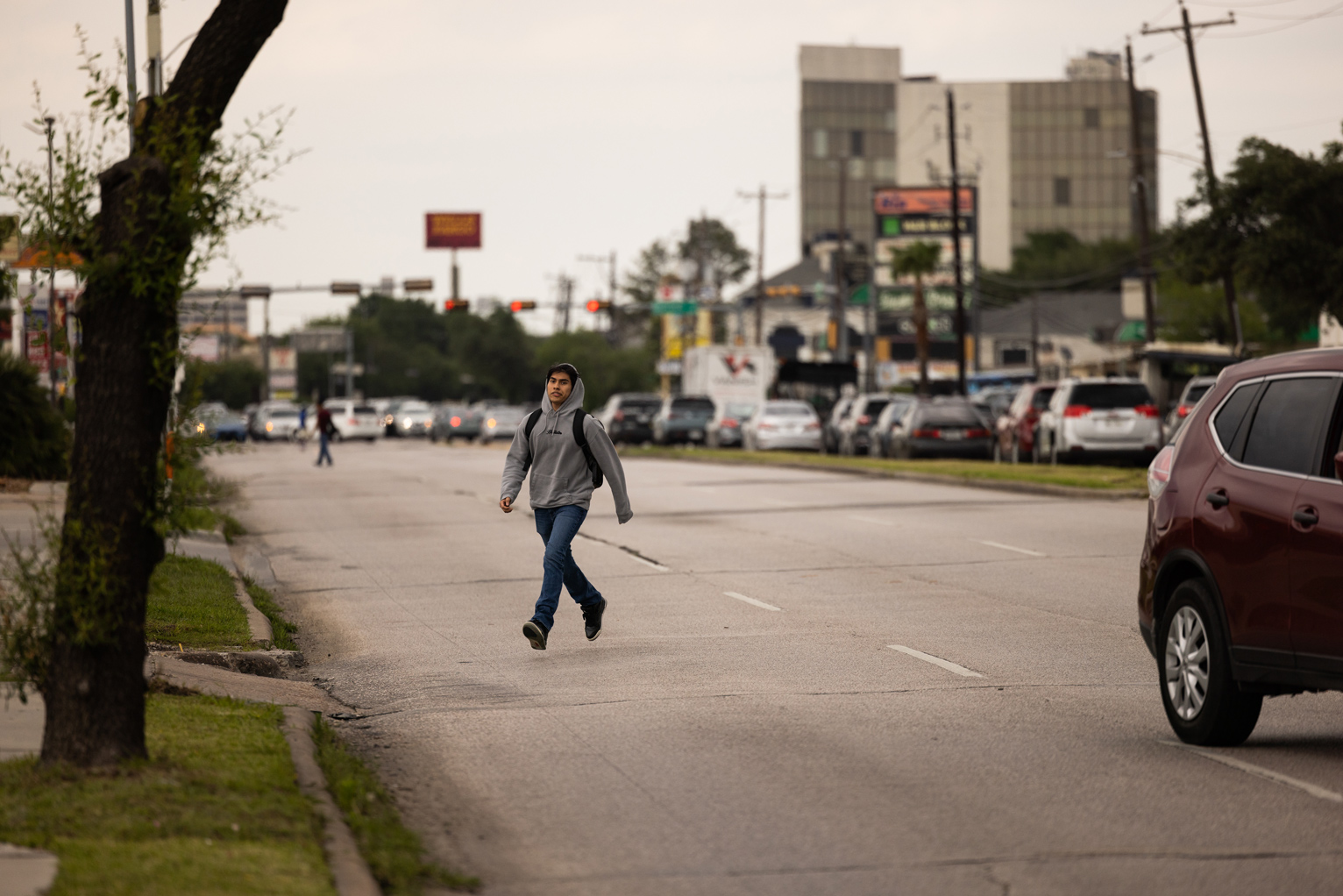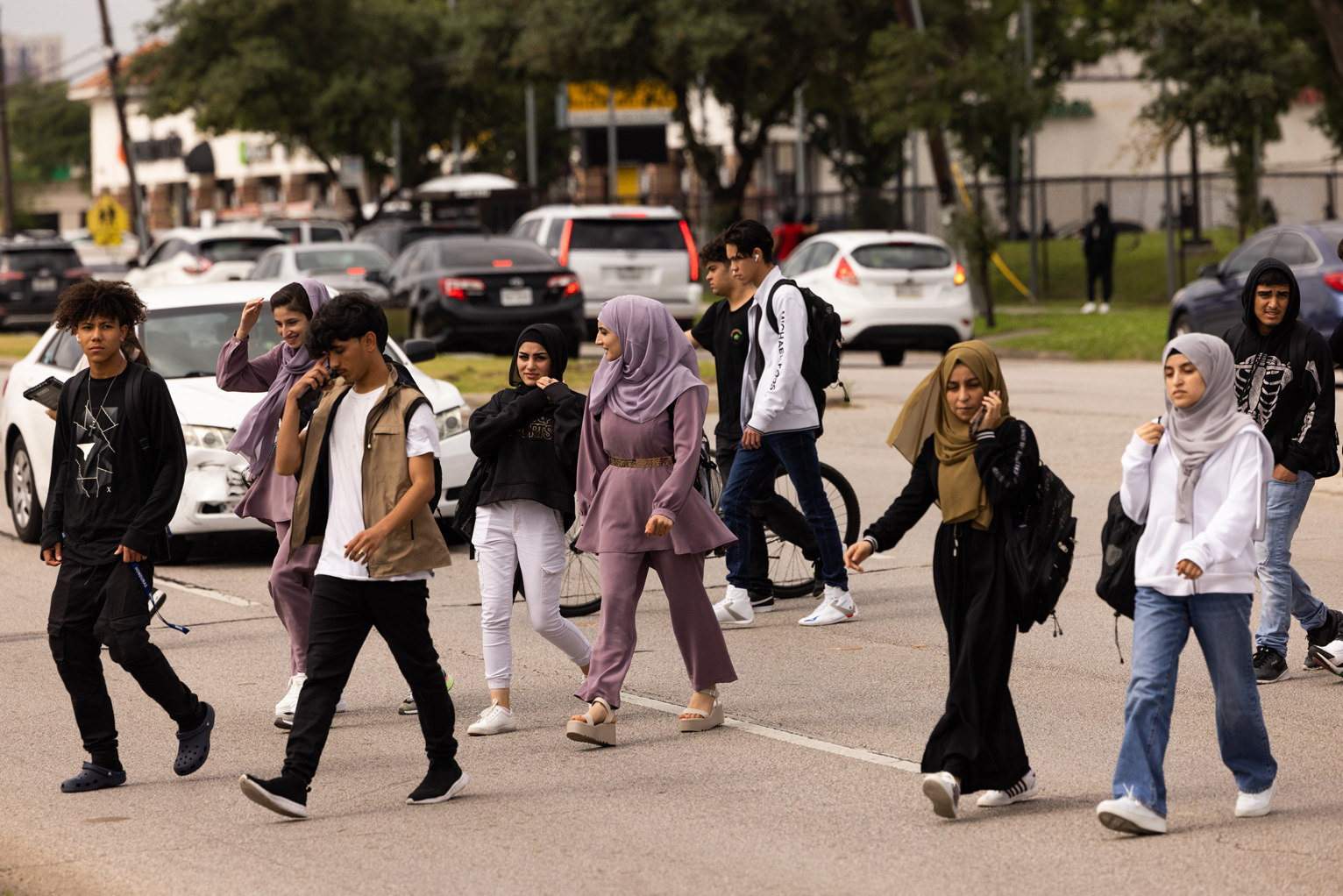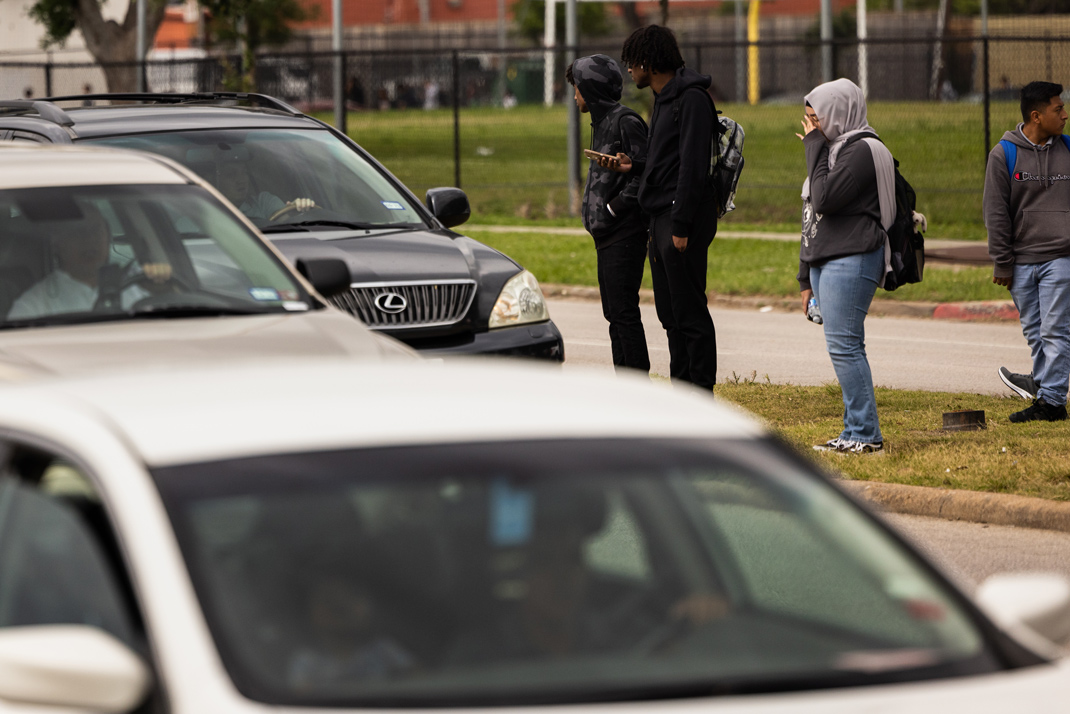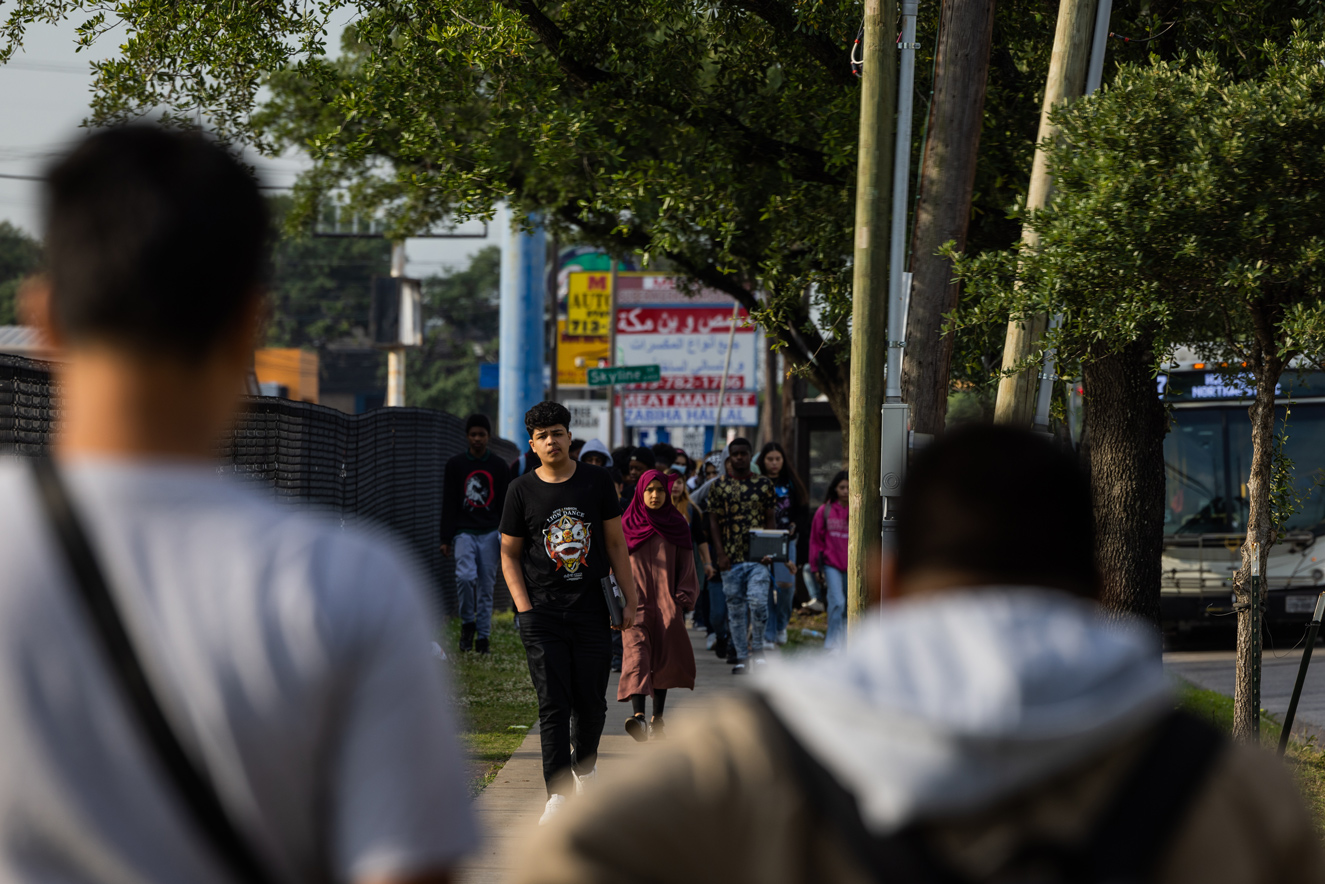|
Getting your Trinity Audio player ready...
|
A lot has changed since Sandra Rodriguez graduated from high school 25 years ago as part of Robert E. Lee’s class of 1998. The school’s name, for instance, is now Wisdom High School.

But some things have remained frustratingly frozen in time — like the dangerous makeshift paths students walk to school, hopscotching across feeder roads without the courtesy of crosswalks.
On a muggy Wednesday morning in early May, Rodriguez — now president of southwest Houston’s Gulfton Super Neighborhood Council — led me along the mile-plus route many students take on foot each morning. We walked over beaten dirt footpaths on Westpark’s south bank, broke a sweat along the Bering Ditch and spoke with students who were less fazed than I was about the journey’s difficulty.
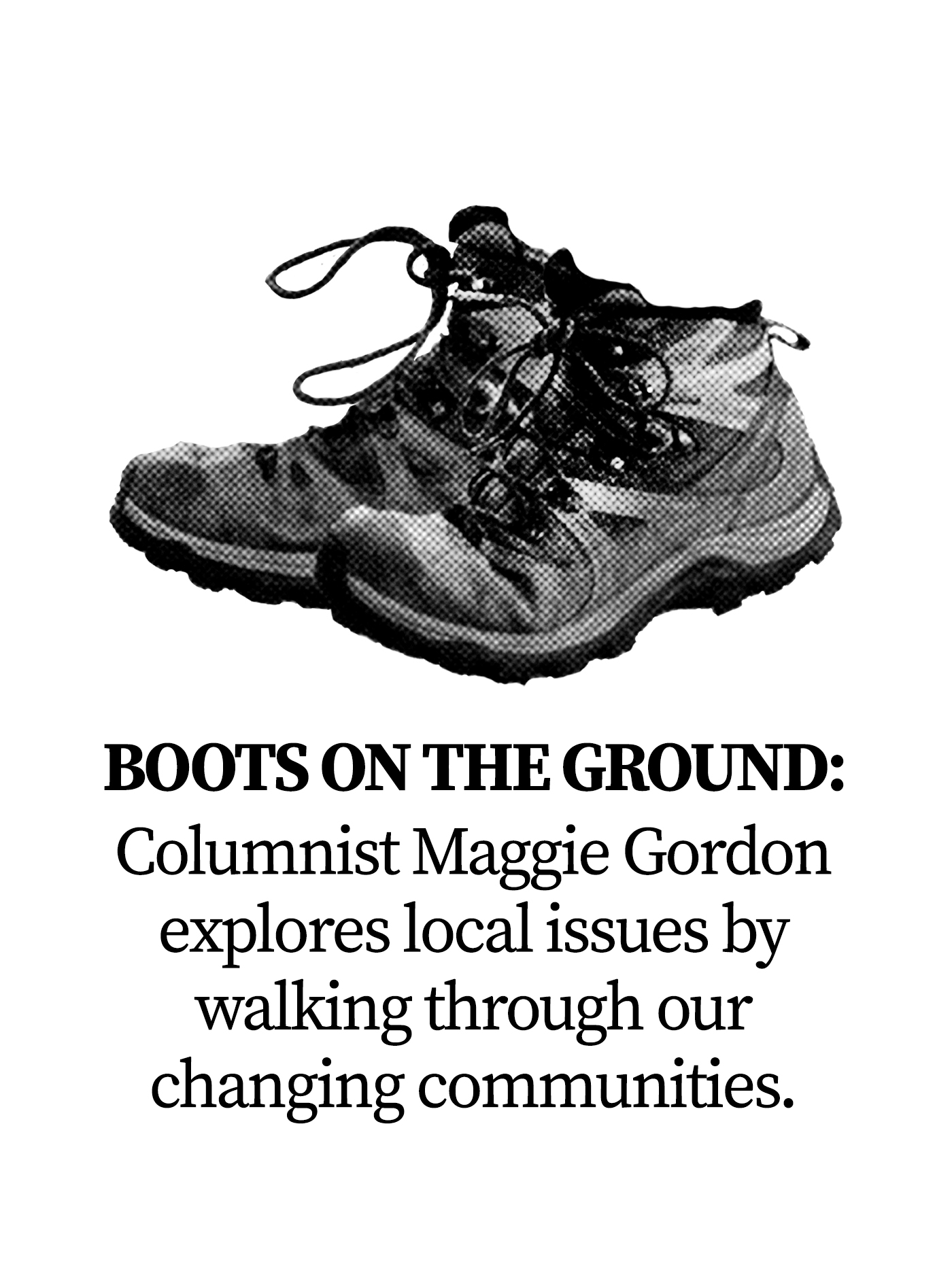
To the students I met, this is normal. But a city and society that normalizes endangering children daily just so they can access a fundamental right like education is failing those children.
Hundreds of Wisdom students live in Gulfton’s massive apartment complexes, separated from school by U.S. 59 and Westpark Tollway. While the physical barriers can make Gulfton feel a world apart from the high school on Hillcroft, they’re less than 2 miles away. And that distance is key: Houston ISD, like other large Texas districts, only provides transit for students who live at least 2 miles from school, forcing many children to find their own way to class.
A treacherous journey
We begin our walk on Rampart Street and Glenmont Drive, where three apartment complexes sit. As we walk north, Rodriguez leads us along a footpath beaten into the grass on this south, sidewalk-less shoulder of Westpark Drive. She stops several times to snap photos of the trash mounds that have piled up to our left — another issue she plans to address.
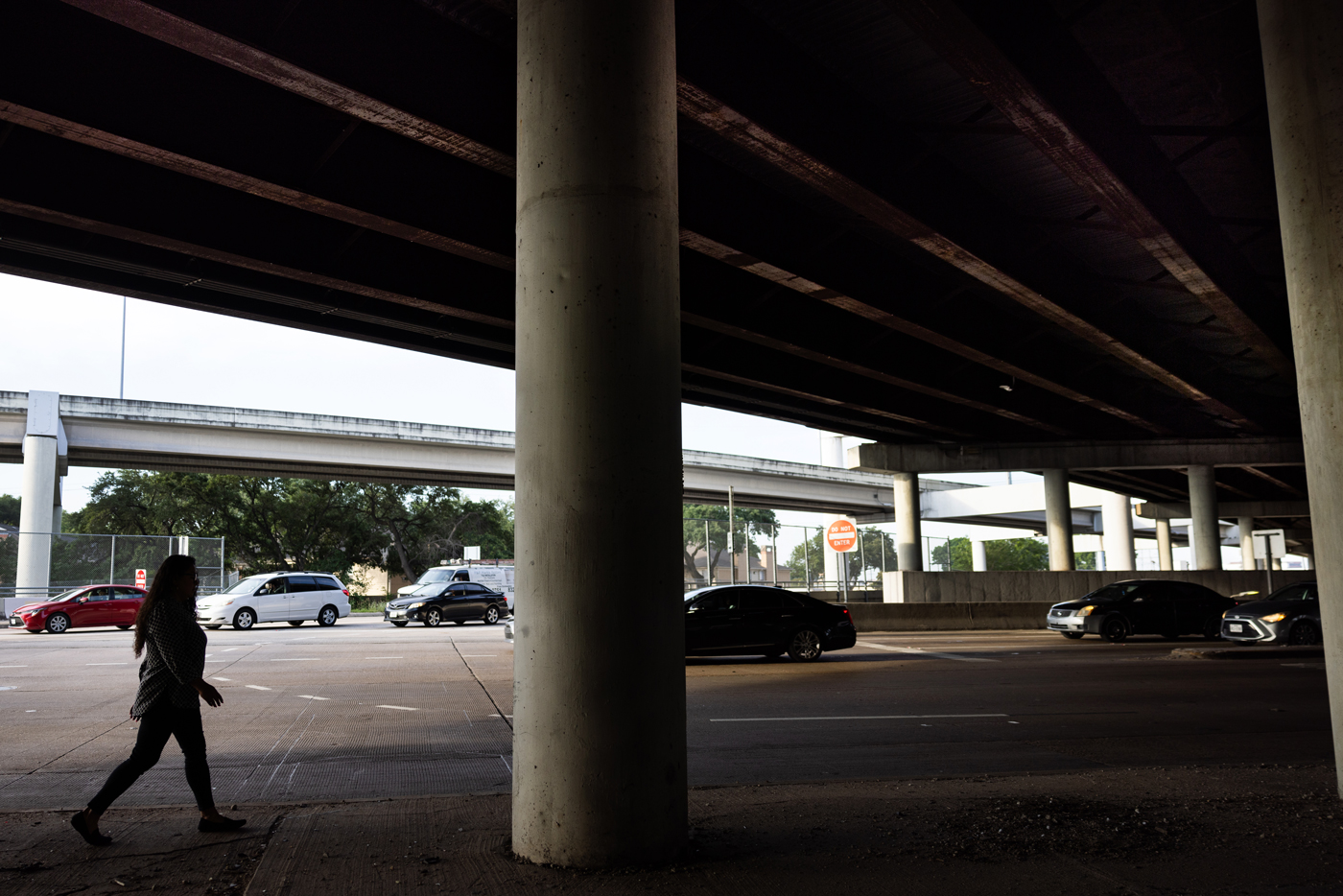
After a block, we hit one of the biggest pain points of the journey: the span of Westpark beneath several overpass lanes of U.S. 59, where long, finger-like islands divide the highway. We manage our way along one of these islands, only to realize there’s no crosswalk connecting us to the sidewalk on the north shoulder.
The speed limit is 40 mph. “They go 60,” Rodriguez notes. As we play a bastardized version of Red Light Green Light meets Chicken to get off the island, I can’t help hyperfocusing on how unfriendly Houston is to pedestrians. In the first three months of 2023, the city logged 45 pedestrian fatalities.
We push westward for several minutes until we hit the Bering Ditch, a concrete channel that Rodriguez remembers walking along as a kid. She points to a crew of workers adding a sidewalk to its east bank. “That’s going to help a lot,” she says.
‘We have only regressed’
Gulfton has long been a landing place for new Americans. About 20 percent of Wisdom students are recent immigrants; 98 percent are deemed “economically disadvantaged” by the state.
“You don’t ask for more, you don’t complain and you don’t push back,” says Rodriguez. “A lot of our families here don’t do that. You’re newcomers, or you’re first generation, and it takes some generations to learn how to stand up and rise up and push back and advocate that you deserve better.”
About the same time Rodrguez graduated from high school, 11-year-old Noelia Fadic’s mother sent her to live with her aunts in Gulfton. The point was to offer Fadic better opportunities than those available in her home country of Bolivia.
Every day, she walked to Jane Long Middle School, sweating in the sun and soaking in the rain — dodging cars the whole way. She, too, was unfazed by the Odyssean journey. This is what had to be done, so she did it without complaint.
But it’s been 25 years since she came here in search of her family’s shot at the American dream — that notion that we can build a better life for our children than the one we experienced, generation by generation.
“I went through it when I was in middle school, and my kids are now in middle school and high school,” she says. “It's been so many years, but we have only regressed. We have not moved forward.”
Now, Fadic is making noise. She attends neighborhood meetings, emails politicians and shows up at City Hall.
“It's sad, because it feels like no one is thinking of our kids,” she says. “Their parents are so busy working, trying to take care of home, that there's no one available to help them.”
Stacking hurdles
By the time Rodriguez and I reach Windswept Lane to turn left off the Bering Ditch, beads of sweat pool along the bottom frame of my glasses. While there’s a push to build sidewalks along the ditch, there’s no tree cover.
That’s not surprising. Gulfton is a neighborhood of superlatives. It’s the hottest spot in the city, due to its lack of trees and surplus of asphalt; a 2020 federal snapshot found Gulfton was 17 degrees hotter than the city’s coolest communities. It’s also Houston’s most densely populated neighborhood, with eight times as many residents per mile as Harris County’s average.
As these hurdles stack on top of each other, so do the opportunities for people to fall through the cracks. In Gulfton, there are three distinct moments of connections that, if missed, can keep a kid from safely accessing school.
If a kid lives more than 2 miles from school, they can take an HISD bus. Inside the radius, they could attempt to hop a city bus. But some kids either can’t afford to take the bus, or can’t afford to wait for a bus that comes every 30 minutes.
If you miss a bus, maybe you could catch a ride with a parent. Or a friend’s parent. But Gulfton residents are also twice as likely to not have a vehicle as the average county resident.
So you’ve fallen through one, two, maybe three backstops. And here you are: walking.
Feeling the heat
That’s what 17-year-old Alex Aleaga was doing when I met him at the intersection of Hillcroft and Skyline, where I crossed like hundreds do every day, in a crosswalk-less intersection. Alex’s family, originally from Cuba, moved to Houston in 2022. He walks 30 minutes each day to reach Wisdom.
“At first it was troubling. There’s cars and they’re not used to people walking in the streets. And they can be disrespectful,” he tells me. “ I get honked at, and when you’re crossing, they don’t slow down.”
While the daily schlep has become his normal routine, his mom still worries. But the bus isn’t an option: The one that passes nearest to his house would force him to wake up by 6:30 a.m. and drop him at school a half-hour before he needs to be there.
I wipe the sweat from my glasses, which have begun fogging. “You ever feel like it’s too hot to walk?”
He pulls at his shirt collar, dappled with sweat. “The afternoons are harder,” he says, “because of the heat.”
The roads between a child’s home and their school are not supposed to be a barrier to education. They’re supposed to be a link. Every child deserves safe passage to their classroom.
If students don’t feel safe, they won’t learn.
“It’s your basic Maslow’s Hierarchy of Needs. You’ve got to have physical, emotional and psychological safety,” Wisdom Principal Kenneth Brantley II tells me. “Without question, this is fundamental.”
Due to the large number of kids walking to school, there’s a well-documented dip in attendance on rainy days. That leads to a funding loss for Wisdom and learning loss for its students.
“The research tells us that we need students in school every single day,” Brantley says. “Consistent access to education is the only way for students to show sustained progress in their academic journey.”

Making some noise
Rodriguez and Fadic spend so much time raising the issue to anyone who will listen that Fadic jokes she has become a “Professional Complainer.”
“We shouldn’t have to make so much noise about this,” Rodriguez says. “But if you don’t, they won’t listen.”
People do seem to be listening at the moment. I’ve spoken with members of City Council, the school district, community organization leaders, representatives from the local tax increment reinvestment zone and a congresswoman about efforts to fix the issues. The congresswoman, U.S. Rep. Lizzie Fletcher, D-Houston, pointed to $500,000 in federal funding recently secured for a study that would diagnose specific issues that need to be fixed.
The problems I spotted throughout the walk are as intersectional as a street map of southwest Houston. There’s an immediate need for better sidewalks. Crosswalks that connect Westpark’s islands to the shoulders on both sides. Tree cover to beat back the heat. Crossing guards near the high school. Flashing lights along Hillcroft that urge speeding traffic to decelerate to a reasonable, school-zone speed.
Maybe the one immediate action we can all take is to ask ourselves if we’d let our kid walk this route every day. And then make some noise.
Share your Houston stories with me. We can start on Twitter, Facebook and Instagram. Or you can email me at [email protected].





